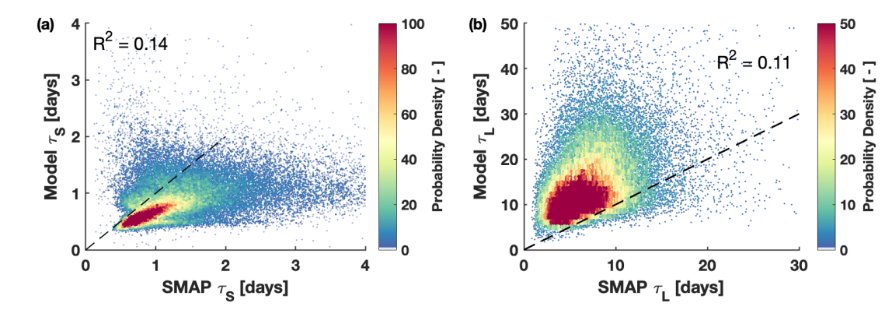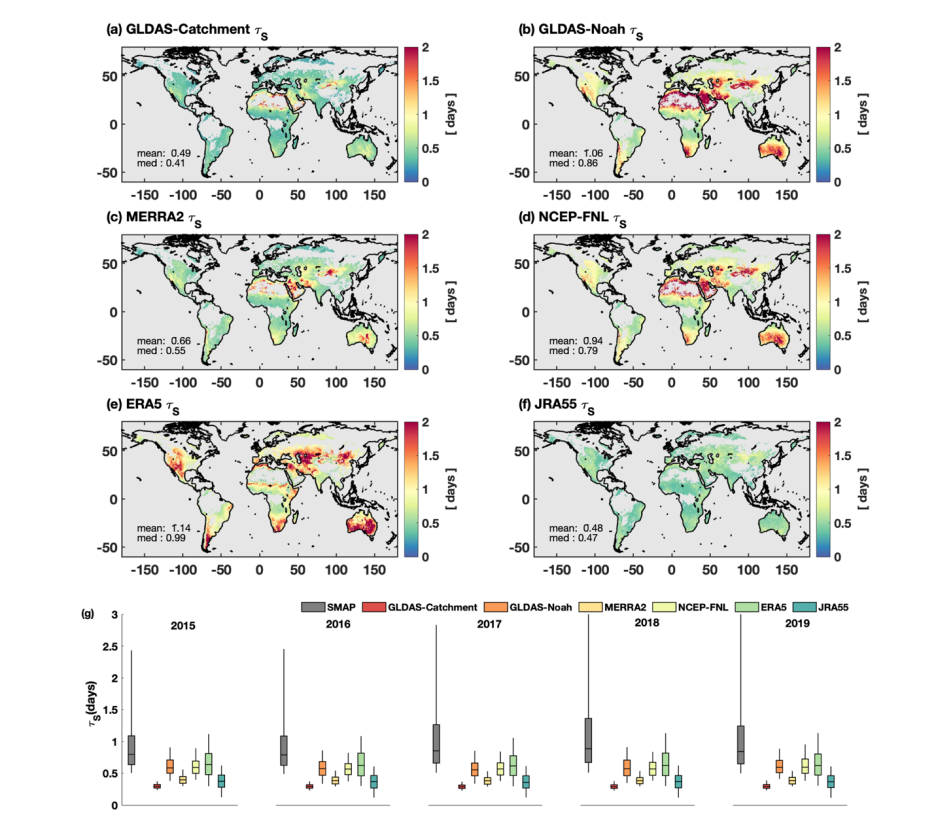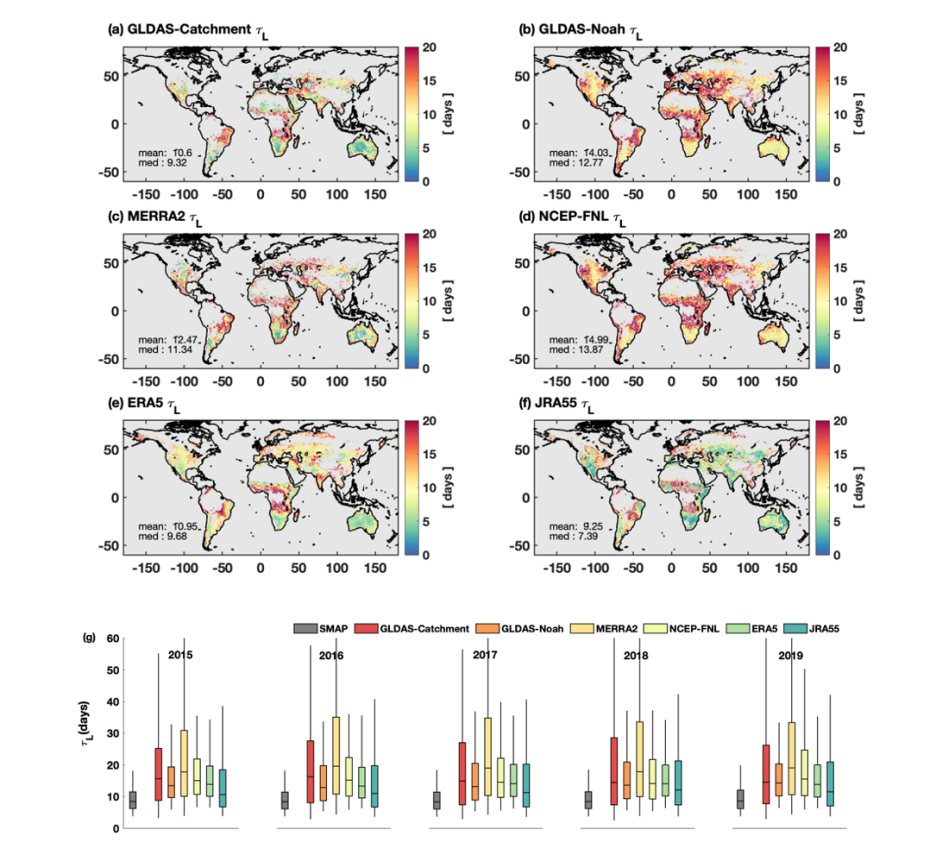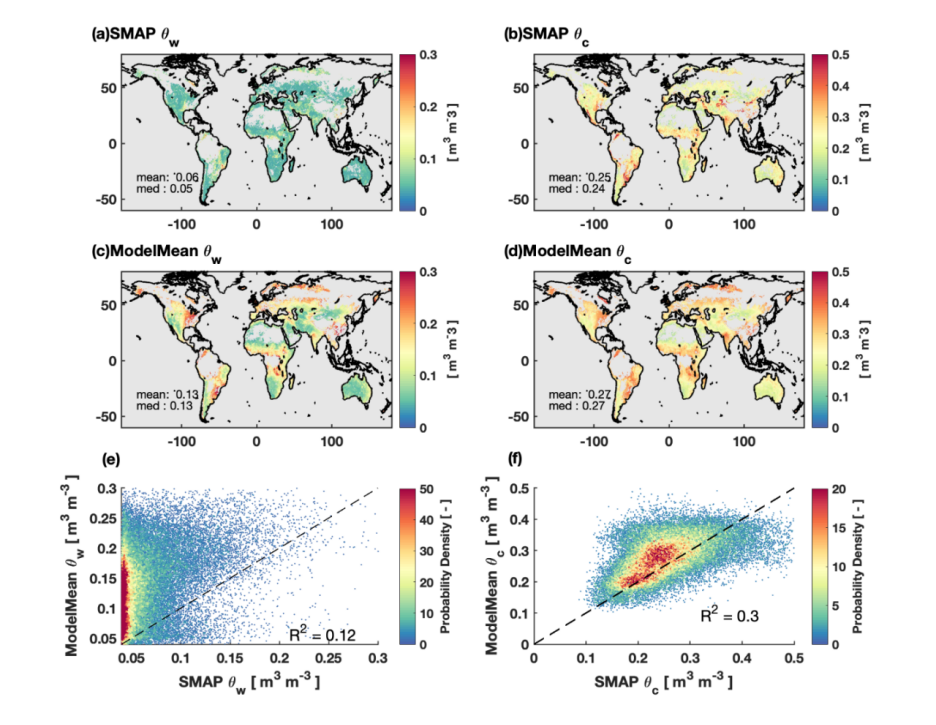How well can current mainstream LSMs simulate the global land-atmosphere interaction? Here’s some information~
Among Earth system models, the simulation ability of land surface models (LSMs) on global land-atmosphere interaction significantly affects the accuracy of weather and climate forecast. However, due to the lack of global observation data, it is difficult to evaluate the simulation ability of the global LSMs for land-atmosphere interaction, which further hinders the improvement and development of the models. In recent years, satellite remote sensing observation has provided global soil moisture data, making possible to evaluate the land-atmosphere interaction simulation ability of LSMs on a global scale.
To address the above problems, Lu Hui's Research Group of the Department of Earth System Science (DESS), Tsinghua University used the surface soil moisture data observed by SMAP (Soil Moisture Active Passive) satellite to retrieve the soil moisture memory time ( and
and  ) based on remote sensing observation, and used it to evaluate the simulation ability of soil moisture memory of four current mainstream LSMs, and to diagnose and analyze the possible sources for biases. In this study, the simulation ability of land-atmosphere interaction of LSMs is systematically evaluated and the bias attribution analysis is carried out by using satellite observation data on a global scale, which can provide important clues and references for improving the simulation and prediction ability of LSMs. The achievement has recently been published as a paper titled “Soil Moisture Memory of Land Surface Models Utilized in Major Reanalyses Differ Significantly from SMAP Observation” in Earth's Future.
) based on remote sensing observation, and used it to evaluate the simulation ability of soil moisture memory of four current mainstream LSMs, and to diagnose and analyze the possible sources for biases. In this study, the simulation ability of land-atmosphere interaction of LSMs is systematically evaluated and the bias attribution analysis is carried out by using satellite observation data on a global scale, which can provide important clues and references for improving the simulation and prediction ability of LSMs. The achievement has recently been published as a paper titled “Soil Moisture Memory of Land Surface Models Utilized in Major Reanalyses Differ Significantly from SMAP Observation” in Earth's Future.

Fig. 1 Scatterplots of multi-model mean of  (a) and
(a) and  (b) versus Soil Moisture Active and Passive estimation.
(b) versus Soil Moisture Active and Passive estimation.

Fig. 2 Global distribution of  for each individual model (a–f) and the intercomparison between their annual variability and Soil Moisture Active and Passive (g).
for each individual model (a–f) and the intercomparison between their annual variability and Soil Moisture Active and Passive (g).

Fig. 3 Global distribution of  for each individual model (a–f) and the intercomparison between their annual variability and Soil Moisture Active and Passive (g).
for each individual model (a–f) and the intercomparison between their annual variability and Soil Moisture Active and Passive (g).
The results show that the soil moisture memory time simulated by LSMs is significantly different from that estimated by satellite. The models overestimate the time  representing the low-frequency soil water loss process, but underestimate the time
representing the low-frequency soil water loss process, but underestimate the time  representing the high-frequency soil water loss process (Fig. 1). It is found that there are also some differences in the simulation performance of
representing the high-frequency soil water loss process (Fig. 1). It is found that there are also some differences in the simulation performance of  and
and  in each model (Figs. 1-3).
in each model (Figs. 1-3).
By comparing the soil depth, parameterization scheme and offline/coupling simulation scheme used in each model, it is found that the performance differences of  and
and  between models are more dependent on the parameterization scheme used, but less dependent on the offline/coupling simulation setting of soil depth and model.
between models are more dependent on the parameterization scheme used, but less dependent on the offline/coupling simulation setting of soil depth and model.

Fig. 4 Global distribution of soil wilting point ( ) and critical point (
) and critical point ( ) for multi-model mean (a–d), and their scatterplot versus Soil Moisture Active and Passive estimations.
) for multi-model mean (a–d), and their scatterplot versus Soil Moisture Active and Passive estimations.
The study also compares two important soil parameters (wilting coefficient and critical point
and critical point  ) related to soil water memory, and finds that the wilting coefficient and critical point of the current mainstream LSMs are quite different from those estimated by remote sensing (Fig. 4). It is further speculated that soil parameters may be an important reason for the deviation of these land surface models from soil moisture memory simulation. Based on the estimated results of SMAP, the surface water cycle rate
) related to soil water memory, and finds that the wilting coefficient and critical point of the current mainstream LSMs are quite different from those estimated by remote sensing (Fig. 4). It is further speculated that soil parameters may be an important reason for the deviation of these land surface models from soil moisture memory simulation. Based on the estimated results of SMAP, the surface water cycle rate  and the second stage evapotranspiration (Stage-II ET) simulated by land model are analyzed and compared. The results show that significant biases can also be found in LSMs in the performance of these two variables.
and the second stage evapotranspiration (Stage-II ET) simulated by land model are analyzed and compared. The results show that significant biases can also be found in LSMs in the performance of these two variables.
He Qing, a doctoral graduate of the DESS, Tsinghua University and postdoctoral fellow of the Department of Civil Engineering, Tokyo University, is the first author of the article, Associate Professor Lu Hui is the corresponding author, and Professor Yang Kun the DESS, Tsinghua University is the co-author. This work was supported by the Second Tibetan Plateau Scientific Expedition and Research Program (STEP) (Grant No. 2019QZKK0206) and the International Cooperate Project of the Chinese Academy of Sciences (Grant No. 182211KYSB20200015).
Article information:
He, Q., Lu, H., & Yang, K. (2023). Soil moisture memory of land surface models utilized in major reanalyses differ significantly from SMAP observation. Earth's Future, 11, e2022EF003215. https://doi.org/10.1029/2022EF003215